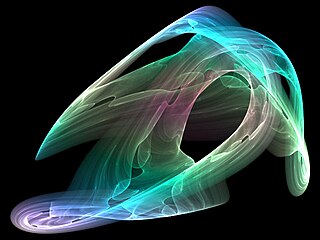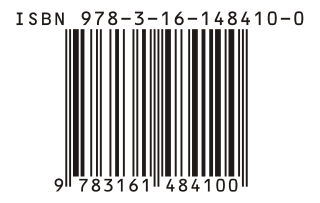In mathematical analysis, the Haar measure assigns an "invariant volume" to subsets of locally compact topological groups, consequently defining an integral for functions on those groups.
In the mathematical field of real analysis, the monotone convergence theorem is any of a number of related theorems proving the convergence of monotonic sequences that are also bounded. Informally, the theorems state that if a sequence is increasing and bounded above by a supremum, then the sequence will converge to the supremum; in the same way, if a sequence is decreasing and is bounded below by an infimum, it will converge to the infimum.
Ergodic theory is a branch of mathematics that studies dynamical systems with an invariant measure and related problems. Its initial development was motivated by problems of statistical physics.
In mathematics, Fatou's lemma establishes an inequality relating the Lebesgue integral of the limit inferior of a sequence of functions to the limit inferior of integrals of these functions. The lemma is named after Pierre Fatou.
In mathematics, the group algebra is any of various constructions to assign to a locally compact group an operator algebra, such that representations of the algebra are related to representations of the group.
In control theory and signal processing, a linear, time-invariant system is said to be minimum-phase if the system and its inverse are causal and stable.
Time evolution is the change of state brought about by the passage of time, applicable to systems with internal state. In this formulation, time is not required to be a continuous parameter, but may be discrete or even finite. In classical physics, time evolution of a collection of rigid bodies is governed by the principles of classical mechanics. In their most rudimentary form, these principles express the relationship between forces acting on the bodies and their acceleration given by Newton's laws of motion. These principles can also be equivalently expressed more abstractly by Hamiltonian mechanics or Lagrangian mechanics.
Linear time-invariant theory, commonly known as LTI system theory, comes from applied mathematics and has direct applications in NMR spectroscopy, seismology, circuits, signal processing, control theory, and other technical areas. It investigates the response of a linear and time-invariant system to an arbitrary input signal. Trajectories of these systems are commonly measured and tracked as they move through time, but in applications like image processing and field theory, the LTI systems also have trajectories in spatial dimensions. Thus, these systems are also called linear translation-invariant to give the theory the most general reach. In the case of generic discrete-time systems, linear shift-invariant is the corresponding term. A good example of LTI systems are electrical circuits that can be made up of resistors, capacitors, and inductors.
In mathematics, more specifically in dynamical systems, the method of averaging exploits systems containing time-scales separation: a fast oscillationversus a slow drift. It suggests that we perform an averaging over a given amount of time in order to iron out the fast oscillations and observe the qualitative behavior from the resulting dynamics. The approximated solution holds under finite time inversely proportional to the parameter denoting the slow time scale. It turns out to be a customary problem where there exists the trade off between how good is the approximated solution balanced by how much time it holds to be close to the original solution.
In mathematics, a π-system on a set Ω is a collection P of certain subsets of Ω, such that

In mathematics, Arnold's cat map is a chaotic map from the torus into itself, named after Vladimir Arnold, who demonstrated its effects in the 1960s using an image of a cat, hence the name.
In mathematics, the attractor of a random dynamical system may be loosely thought of as a set to which the system evolves after a long enough time. The basic idea is the same as for a deterministic dynamical system, but requires careful treatment because random dynamical systems are necessarily non-autonomous. This requires one to consider the notion of a pullback attractor or attractor in the pullback sense.
In mathematics, a cardinal function is a function that returns cardinal numbers.
In mathematics — specifically, in ergodic theory — a maximising measure is a particular kind of probability measure. Informally, a probability measure μ is a maximising measure for some function f if the integral of f with respect to μ is “as big as it can be”. The theory of maximising measures is relatively young and quite little is known about their general structure and properties.
In mathematics, the Pettis integral or Gelfand–Pettis integral, named after Israel M. Gelfand and Billy James Pettis, extends the definition of the Lebesgue integral to vector-valued functions on a measure space, by exploiting duality. The integral was introduced by Gelfand for the case when the measure space is an interval with Lebesgue measure. The integral is also called the weak integral in contrast to the Bochner integral, which is the strong integral.
In functional analysis, a branch of mathematics, the algebraic interior or radial kernel of a subset of a vector space is a refinement of the concept of the interior. It is the subset of points contained in a given set with respect to which it is absorbing, i.e. the radial points of the set. The elements of the algebraic interior are often referred to as internal points.

In functional analysis and related areas of mathematics, stereotype spaces are topological vector spaces defined by a special variant of reflexivity condition. They form a class of spaces with a series of remarkable properties, in particular, this class is very wide, it consists of spaces satisfying a natural condition of completeness, and it forms a *-autonomous category with the standard analytical tools for constructing new spaces, like taking dual spaces, spaces of operators, tensor products, and in addition, immediate subspaces, immediate quotient spaces, products and coproducts, limits and colimits, etc.
In applied mathematical analysis, shearlets are a multiscale framework which allows efficient encoding of anisotropic features in multivariate problem classes. Originally, shearlets were introduced in 2006 for the analysis and sparse approximation of functions . They are a natural extension of wavelets, to accommodate the fact that multivariate functions are typically governed by anisotropic features such as edges in images, since wavelets, as isotropic objects, are not capable of capturing such phenomena.
In mathematics, Lie group–Lie algebra correspondence allows one to study Lie groups, which are geometric objects, in terms of Lie algebras, which are linear objects. In this article, a Lie group refers to a real Lie group. For the complex and p-adic cases, see complex Lie group and p-adic Lie group.

In numerical mathematics, the gradient discretisation method (GDM) is a framework which contains classical and recent numerical schemes for diffusion problems of various kinds: linear or non-linear, steady-state or time-dependent. The schemes may be conforming or non-conforming, and may rely on very general polygonal or polyhedral meshes.











